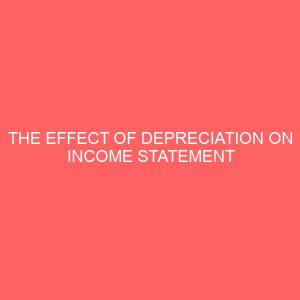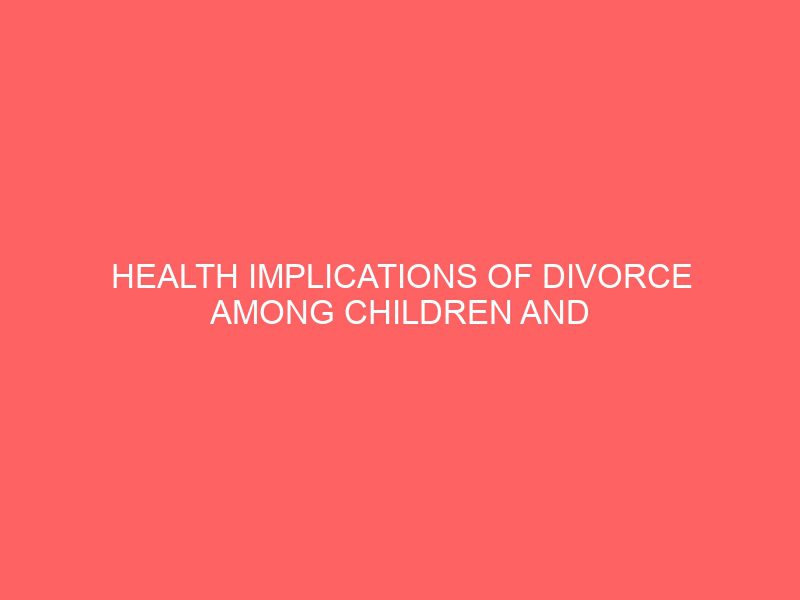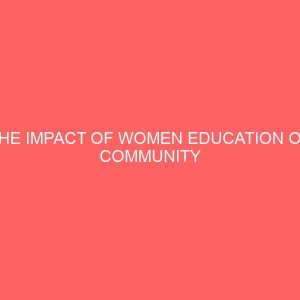Description
CHAPTER ONE
INTRODUCTION
1.1 Background of the study.
This research is on Health implications of divorce among children and mothers in jaba local government area of kaduna state. Marriage is as old as man himself. It is a socially recognized and approved union between individuals, who commit to one another with the expectation of a stable and lasting intimate relationship (Ahron Constance, 2004). It begins with a ceremony known as a wedding, which formally unites the marriage partners. A marital relationship usually involves some kind of contract, either written or specified by tradition, which defines the partners’ rights and obligations to each other, to any children they may have, and to their relatives. In most contemporary industrialized societies, marriage is certified by the government. In addition to being a personal relationship between two people, marriage is one of society’s most important and basic institutions. Marriage and family serve as tools for ensuring social reproduction. Social reproduction includes providing food, clothing, and shelter for family members; raising and socializing children; and caring for the sick and elderly. In families and societies in which wealth, property, or a hereditary title is to be passed on from one generation to the next, inheritance and the production of legitimate heirs is a prime concern in marriage. However, in contemporary industrialized societies, marriage functions less as a social institution and more as a source of intimacy for the individuals involved. When the primary purpose of this sacred union is defeated and no longer seen as an ideal agreement by the partners involved, an annulment of the marriage vows is embarked on which is divorce and this exonerates both partners of their marital rights and vows. Divorcé which is the legal dissolution of a marriage contracted between a man and a woman. It is legal in the sense that its dissolution is affected by a reputed court of law. It is the court of law that determines the end of marriage by the term “divorce”. Divorce is quite different from separation between a husband and wife that are not legally married. It then means that, Divorce is distinguished from annulment, which declares a marriage void from the time of its celebration.
Barlet (2004) posited that Divorce is so widespread in our society that an intelligent study of divorce is necessary if one is to have the attitude and understanding that will help him/her build a good marriage and avoid eventuality of divorce. According to the World Health Organization (WHO), Health is a state of complete physical, social and mental well-being and not merely the absence of disease or infirmity. Based on this definition, it is virtually impossible to attain complete state of health in divorce. This correlates divorce and its health implication generally on men, women, children and also its adverse effects on the society at large. Studies have shown that divorce has its massive effects more on women and children since it is believed that women are the weaker sex although this research is not based on that ideology but at the same time on the health implications on women and children.
According to a New York Times article, “More Americans Rejecting Marriage in 50s and Beyond”. In the past 20 years, the divorce rate has increased over 50% amongst the baby boomers. More and more adults are staying single and according to an analysis of census data conducted at Bowling Green State University in Ohio, they say the divorce numbers will continue to rise. Baby boomers that remain unmarried are five times more likely to live in poverty compared to those who are married. According to the statistics, it will also be three times as hard to receive food stamps, public assistance or disability payment
According to Lawson (2002) Sociologists believe that the rise in the number of older Nigerians who are not married is a result of factors such as longevity and economics. Women, especially, are becoming more and more financially independent which allows them to feel more secure with being alone. In previous generations, being divorced or single was seen differently than it is now. This has resulted in less pressure for baby boomers to marry or stay married. Therefore the study seeks to explore health implications of divorce among children and mothers in Jaba Local Government Area of Kaduna State in Nigeria.
1.2 Statement of Problem
According to Bramlet (2001) divorce no longer seems a hard decision to come by due to the intensive increase in divorce rate. In Nigeria, between 2003 to 2005 divorce had risen by 70% as estimated by court statistics. Individuals tend to see divorce as an escape route to marital issues and incompetence when in the actual sense divorce expands the issues and make them complex exposing them to more dangers than is already experienced. Many years ago, the mere mention of divorce aroused massive attention but with the level exposure and association with the western world where divorce seem to be as easy and instant as marriage vows. The health implications of divorce on children amount to their the effects it has on the education, relationship with parents and peergroup ,religious effects, social effects, psychological effects amongst others. This observations motivated this study and is carefully analyzed.
1.3 Purpose of the study
The main purpose of the study was to determine the health implications of divorce on children and mothers in Jaba LGA of Kaduna state
Objectives of the study
Specifically, the objectives were;
- To determine the physical health implications of divorce on mothers and children
- To determine the emotional health implications on children and mothers.
- To determine the social health implications of divorce on mothers and children
- To determine the predisposing factors to divorce among couples in Jaba LGA.
- To determine if the social health implications differ according to women of different religious background.
- To determine if the physical health implications of divorce is related to the age of the children.
1.4 Research Questions
- What are the physical health implications of divorce on children nd mothers?
- What are the emotional health implications of divorce on children and mothers?
- What are the social health implications of divorce on children and mothers.
- What are the predisposing factors to divorce in Jaba LGA.
- Are there differences in social health implications among women according to different religious backgrounds?
- Are the physical health implications of divorce related to the age of children?
1.5 Research hypotheses
There is no significant difference in social health implications among women according to religious background.
There is no relationship between the physical health implications on children according to age.
1.6 Significance of study
The findings and recommendations from this study will be of immense value to these various groups:
- The women of Jaba Local Government Area of Kaduna State who are in a better position to outline their differences in life as both married and divorcees.
- The children in Jaba Local Government that will share their experiences a children of divorcees or married parents.
- The children in Jaba Local Government share their experiences a children of divorcees or married parents.
- The women and children will be made to understand the various health implications of divorce on them.
- The People of Jaba Local Government generally and the society at large will be informed about the health implications of divorce ,preventive measures against divorce as an ultimatum.
- This study will be a reference point for some students who may wish to carry out research work on similar topics in the future.
- To health workers, social workers and the public generally, it will unfold the negative health effects surrounding divorce.
1.7 Scope of study
The study focuses on health implications of divorce among children and mothers in Jaba Local Government Area of Kaduna State in Nigeria. Specifically, villages like Sabonsarki, Sabangida, Habori, Kwaturu, Gidantagai and Jibir of Kaduna State will be investigated to find out the relationship between the independent and the dependent variable.








